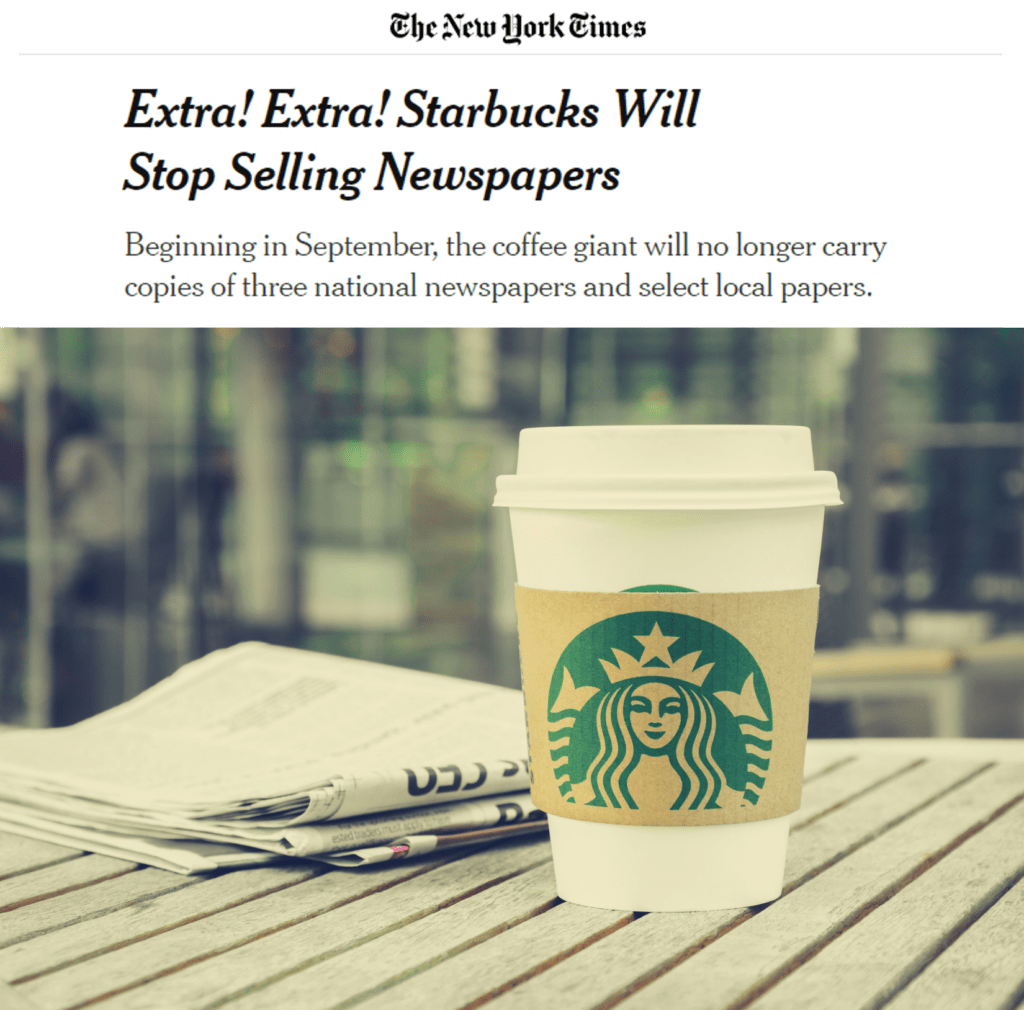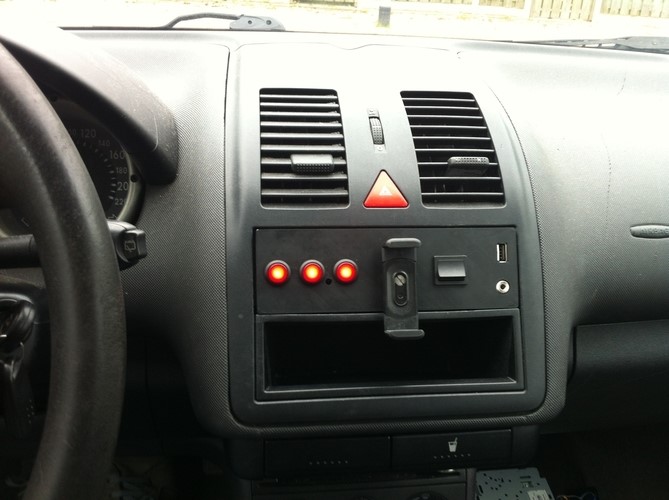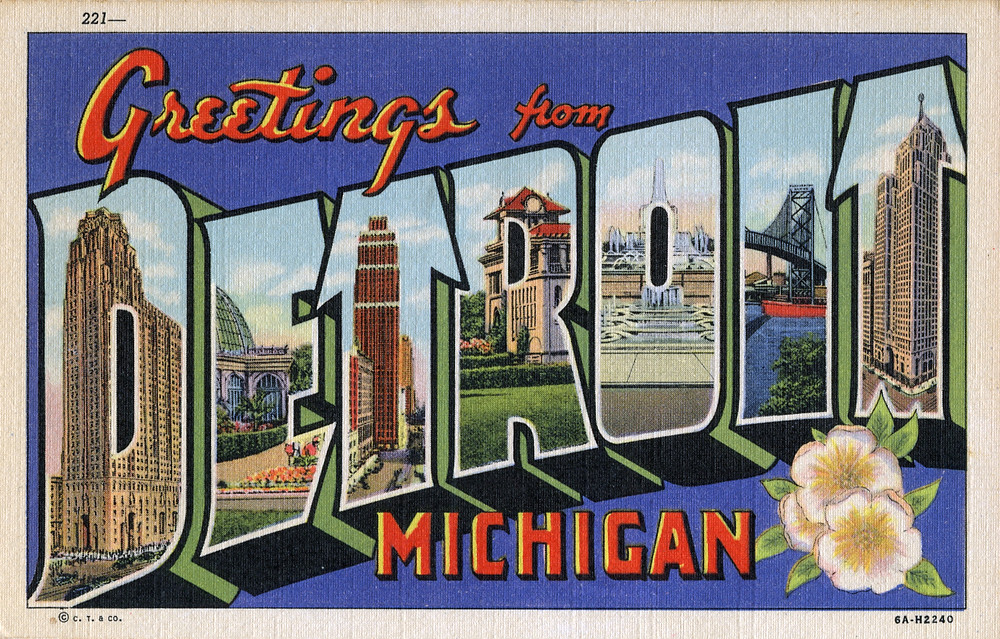
It was just another Saturday in The New York Times, but the headline was as powerful as the news out of Iran or the White House. Starting this fall, the more than 8,600 Starbucks stores that have traditionally carried the Times, the Wall Street Journal, and USA Today will cease to do so. Starbucks did not provide a rationale for this new policy change, nor did The New York Times seem to have a clue. As they reported, “Starbucks did not give a reason for the change,” sounding about as surprised as millions of latte drinkers.
I’ve heard people point out that newspapers will still be available to Starbucks customers on their mobile phones, tablets, and laptops – frequently seen throughout their stores. But the decision to stop selling physical newspapers at Starbucks goes further than a loss of revenue. It’s an acknowledgment that newspaper readers are not part of the Starbucks demographic or lifestyle.
A little back of the napkin math tells you if every Starbucks store sold 5 copies of the Times each weekday, it would come to a loss of roughly 43,000  papers a day. Against daily sales of 487,000, that’s nearly a 10% bite – not an insubstantial hit to their circulation. But beyond the bottom line, the bigger loss is one of proximity, presence, and even face.
papers a day. Against daily sales of 487,000, that’s nearly a 10% bite – not an insubstantial hit to their circulation. But beyond the bottom line, the bigger loss is one of proximity, presence, and even face.
This would be a tough one to swallow for any media brand, especially traditional outlets like physical newspapers. They’re literally in the fight of their lives every day. A rejection from Starbucks is just another sign to their readers, their advertisers, and their staffers that their business is endangered.
Radio people ought to be able to relate. Since our company began our industry focus on the car dashboard more than a decade ago, we’ve heard broadcasters fearfully ask whether automakers might one day stop including AM/FM radios as standard equipment in their new makes and models. AM radio has already come under fire by BMW and Tesla – both of whom have eschewed amplitude modulation in their electric car models.
It’s not impossible to imagine the day when automakers amp up their focus on revenue, especially media outlets that provide money in exchange for dashboard “real estate.” And if that day approaches, the radio broadcasting industry better have a solid relationship with global car makers.

Reading The New York Times story, it’s hard not to get the impression the publishers may not have been in regular contact with the Starbucks marketing team. Perhaps, they even took it for granted that “All the News That’s Fit to Print” would forever have a place on racks next to Starbucks’ cash registers. Not even knowing the reason why their physical newspapers were tossed speaks to a weak relationship with a key vendor/distributor.
And in fact, it should serve as a cautionary tale for radio broadcasters. For decades, automakers have included broadcast radios as standard equipment in nearly all their cars and trucks. And who has made money from that relationship? Certainly not automakers.
That’s why efforts the NAB have undertaken in the past few years to reach out and connect with car companies, their executives, and their suppliers should be supported by every broadcaster. Relationships matter. They may not guarantee radio’s place in the dashboard for time immemorial. But they will most certainly keep the radio medium top of mind and present in the minds of the auto community.
Part of the fallout from the Digital Age is that decisions are made faster and with less forethought. The whole idea behind agile brands is their ability to make quick pivots when desirable or necessary. That doesn’t always lead to great decision-making as Starbucks and the Times may come to find out.
But for the future of radio’s presence in dashboards, the potential fallout would easily surpass the 10% threshold, promising a long nuclear winter  of pain and anguish.
of pain and anguish.
A smart mobile and voice strategy, as well as developing strong, local brands that matter to consumers go to the heart of radio’s survival in cars – and in other locations.
But so does the industry’s engagement with the automotive powers that be. That means a continued strong presence at CES, the biggest auto shows, and other get-togethers that involve automakers – their executives, engineers, and marketers.
But local broadcasters shouldn’t just count on their N Street reps to lobby on radio’s behalf. There’s partnership opportunities via local car dealerships and dealer groups. And while these include monetary rewards, they also go to heart of broadcasters establishing stronger ties to hometown car and truck sellers, the conduit to the big automakers.
There’s also no better time for America’s radio honchos to reach out to Detroit to keep those fires burning. Many of radio’s closest competitors – SiriusXM, Pandora, Spotify, and others – have set up shop in Metro Detroit. The NAB should, too.
And maybe someday, the Radio Show will make its way to the Motor City.
Now that’s a headline we’d like to see.
- What To Do If Your Radio Station Goes Through A Midlife Crisis - April 25, 2025
- A 2020 Lesson?It Could All Be Gone In A Flash - April 24, 2025
- How AI Can Give Radio Personalities More…PERSONALITY - April 23, 2025




Every business move should be guided by the question:
At what cost?
Sometimes the cost isn’t pinpointed on a spread sheet.
The feeling of “exclusion” can be a cost.
I know two people who have changed their new car purchases because there was no CD player offered in the model they liked.
If I ran a coffee shop, it would be last one to not offer reading options.
If I ran a car company, I would be touting that your kids can still play their CD’s in our SUV’s.
I get the concept of moving ahead…
I just don’t get moving beyond, and thus excluding, the mainstream.
I don’t know why businesses (or radio stations) take things away and hope their customers don’t notice. They do.
This smacks of the arrogance GM showed back in the ’90’s, when they tested the “new” Chevy Impala/Caprice, the one that looked like an upside-down bathtub. ALL the focus groups turned thumbs down, due to how ugly it was. GM built it anyway. Truth be known, it wouldn’t cost doodly squat for the automakers to include all the well-known platforms in the dash, rather than to assume that they know what we’ll like.
Dan, here’s the crazy part – FM radio “tests” exceptionally well. AM, not as robust, but still there’s a demand. I don’t expect anything will change in the next several years, but as a friend in the industry now says, no one can say that with certainty. So the challenge to us in radio is to collectively keep demand as high as possible by continuing to provide a relevant, vibrant service. In this financial and competitive environment, that’s not a slam dunk.
Fred, are you certain the NYT is distressed by the Starbucks decision? (I think your estimate of five newspapers sold per Starbucks is way high, but never mind that.)
The NYT is positioned for this, with a mature, growing digital product. In “my” Starbucks locations (Durham, NC and the metros where we produce conferences) approximately nobody is reading a print paper. Approximately everybody is is holding a device. This seems like a clean, sensible decision that doesn’t damage the NYT (much), and aligns with trend. Could have been made two years ago.
Your comparison to radio in cars is a good one … though I venture that the car is fantastically more important to radio than Starbucks is to the NYT. How is radio coming along with its mature, robust digital product? That’s a snarky question, but IMO the answer is “pretty good” — everyone streams, at least. NextRadio was preposterous for phones, but a basic stream is fine for a digital dashboard screen.
How’s podcasting coming along in commercial radio? That’s a much snarkier question, and the answer is baffling to me. (Not disregarding your efforts at Podcast Movement.)
NAB in Detroit? Excellent suggestion. This week, Podfront is producing a (mostly unpublicized) upfront event for the Detroit ad-buying community. THAT is a foretelling signal. Podcasting is a match for cars, a category brimming with original content produced by many types of media organizations, brands, and public radio. Where, where, where is commercial radio? Podcasting is not rocket science! Radio has immense production and promotion advantages that every indie podcaster, and many brand podcasts, envy.
That was a tangent. But there is a titanic missing-the-boat factor here.
Brad, I love comments like this. Let me take ’em in order:
1. You’re probably correct that the end of print in most Starbucks will be something of a non-event. But there are a fair amount of AARP members who are regulars in these stores that will feel the effects. I agree the damage will be less about a loss of sales, and more about the loss of face and swagger. I realize you can’t quantify this stuff, but it’s another brick in the wall, so to speak.
2. You’re correct the threat to radio is considerably greater – and of course, that’s why I wrote the post. I do believe the NY Times must not have been in close touch with a key distributor – Starbucks. I would hate to see radio repeat that mistake with OEMs.
3. Radio is grappling with podcasting, and as the last year show, more and more stations are buying their way into the space. I’m thrilled we’re continuing our “Broadcasters Meet Podcasters” track at Podcast Movement, but realize radio needs to take this platform more seriously.
4. As for the NAB in Detroit, please come.
Fred, your piece is spot on. I hope the good Senator from Oregon reads this and moves the Radio Show to Detroit. Time is of the essence. It is about relevance and with the positive audio pieces that have been released in the last sixty days combined with your framing the issue for RADIO…the time is now to make that happen! I know we have talked about this after I made a recent National sales trip to Detroit. That city has transformed itself the same way we need to.
M2
Milt, the question has changed from “Is there anywhere decent here to eat?” to “Which of the new downtown restaurants do we want to try tonight?” Good things are happening here, and despite the economic and societal turbulence here, Detroit remains the auto center of the world. It is so important for radio to have presence here. Thanks for the supportive words.